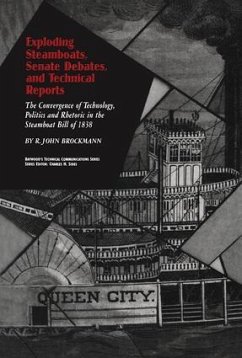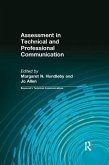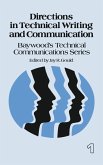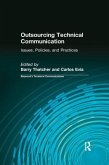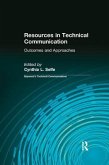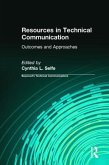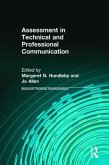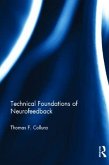R. John Brockmann
Exploding Steamboats, Senate Debates, and Technical Reports
The Convergence of Technology, Politics, and Rhetoric in the Steamboat Bill of 1838
R. John Brockmann
Exploding Steamboats, Senate Debates, and Technical Reports
The Convergence of Technology, Politics, and Rhetoric in the Steamboat Bill of 1838
- Broschiertes Buch
- Merkliste
- Auf die Merkliste
- Bewerten Bewerten
- Teilen
- Produkt teilen
- Produkterinnerung
- Produkterinnerung
By 1838, over two thousand Americans had been killed and many hundreds injured by exploding steam engines on steamboats. After calls for a solution in two State of the Union addresses, a Senate Select Committee met to consider an investigative report from the Franklin Institute of Philadelphia, the first federally funded investigation into a technical.
Andere Kunden interessierten sich auch für
![Assessment in Technical and Professional Communication Assessment in Technical and Professional Communication]() Assessment in Technical and Professional Communication78,99 €
Assessment in Technical and Professional Communication78,99 €![Directions in Technical Writing and Communication Directions in Technical Writing and Communication]() Jay R GouldDirections in Technical Writing and Communication227,99 €
Jay R GouldDirections in Technical Writing and Communication227,99 €![Outsourcing Technical Communication Outsourcing Technical Communication]() Barry ThatcherOutsourcing Technical Communication68,99 €
Barry ThatcherOutsourcing Technical Communication68,99 €![Resources in Technical Communication Resources in Technical Communication]() Cynthia L SelfeResources in Technical Communication79,99 €
Cynthia L SelfeResources in Technical Communication79,99 €![Resources in Technical Communication Resources in Technical Communication]() Cynthia SelfeResources in Technical Communication206,99 €
Cynthia SelfeResources in Technical Communication206,99 €![Assessment in Technical and Professional Communication Assessment in Technical and Professional Communication]() Assessment in Technical and Professional Communication206,99 €
Assessment in Technical and Professional Communication206,99 €![Technical Foundations of Neurofeedback Technical Foundations of Neurofeedback]() Thomas F. ColluraTechnical Foundations of Neurofeedback238,99 €
Thomas F. ColluraTechnical Foundations of Neurofeedback238,99 €-
-
-
By 1838, over two thousand Americans had been killed and many hundreds injured by exploding steam engines on steamboats. After calls for a solution in two State of the Union addresses, a Senate Select Committee met to consider an investigative report from the Franklin Institute of Philadelphia, the first federally funded investigation into a technical.
Hinweis: Dieser Artikel kann nur an eine deutsche Lieferadresse ausgeliefert werden.
Hinweis: Dieser Artikel kann nur an eine deutsche Lieferadresse ausgeliefert werden.
Produktdetails
- Produktdetails
- Verlag: Routledge
- Seitenzahl: 158
- Erscheinungstermin: 21. Januar 2019
- Englisch
- Abmessung: 229mm x 152mm x 9mm
- Gewicht: 240g
- ISBN-13: 9780415404112
- ISBN-10: 0415404118
- Artikelnr.: 55001835
- Herstellerkennzeichnung
- Libri GmbH
- Europaallee 1
- 36244 Bad Hersfeld
- gpsr@libri.de
- Verlag: Routledge
- Seitenzahl: 158
- Erscheinungstermin: 21. Januar 2019
- Englisch
- Abmessung: 229mm x 152mm x 9mm
- Gewicht: 240g
- ISBN-13: 9780415404112
- ISBN-10: 0415404118
- Artikelnr.: 55001835
- Herstellerkennzeichnung
- Libri GmbH
- Europaallee 1
- 36244 Bad Hersfeld
- gpsr@libri.de
R. John Brockman
CHAPTER 1. Steamboat Politics and Steamboat Society
New York Harbor, May 15, 1824, 7:00 PM
Four Days Later-Washington City, May 19, 1824
CHAPTER 2. Steamboat Technology
High-Pressure Steam Engines and Hulls that Ride On the Water
What Could Go Wrong with the Boiler Technology
Problems Operating a Problem-Prone Technology
February 24, 1830, Memphis Tennessee, Early Morning
Washington City, May 4, 1830-Two and a Half Months Later
CHAPTER 3. Steamboats, The Presidency, and Public Opinion
Red River, May 19, 1833, Early on a Spring Sunday Morning
December 3, 1833-President Jackson's State of the Union Message to Congress
But What About the Public Pressure for Steamboat Safety?
The Franklin Institute Reports-A Reasoned Technical Response to Catastrophe
Traditional Technical Writing of the Era-Communications Received by the
Committee of
the Franklin Institute on the Explosion of Steam Boilers (1832)
Report of the Committee of the Franklin Institute of the State of
Pennsylvania for the
Promotion of the Mechanic Arts, on the Explosions of Steam-Boilers, Part I,
Containing
the First Report of Experiments Made by the Committee for the Treasury
Department of
the U. States (1836)
General Report on the Explosions of Steam-Boilers by a Committee of the
Franklin Institute
of the State of Pennsylvania for the Promotion of the Mechanic Arts (1837)
Report of the Committee of the Franklin Institute of the State of
Pennsylvania for the
Promotion of the Mechanic Arts, on the Explosions of Steam-Boilers Made at
the
Request of the Treasury Department of the United States, Part II,
Containing the Report
of the Sub-Committee to Whom Was Referred the Examination of the Strength
of
Materials Employed in the Construction of Steam Boilers (1837)
Contemporaneous Reactions to the Institute Reports in the Scientific
Community: Hales's
Open Letter to Grundy, Locke's Cincinnati Report, and Steam Textbooks by
Renwick
and Ward
Contemporaneous Reactions to Institute's Reports by Those Most Directly
Involved:
Steamboat Inspectors, Engineers, and Firemen
The Gold Dust Fire
Chapter 37. The End of the "Gold Dust"
Chapter 20. A Catastrophe
CHAPTER 4. Steamboat Politics and Rhetoric
May 11, 1837, Thirty Miles South of Natchez
A Brief Coincidence of Political Interests
The Select Committee
The Initial Proposed Bill in December 1837
The Bill Reported Out of Committee
CHAPTER 5. The Law Didn't Work
GLOSSARY
APPENDIX 1. Comparing the Four Legislative Attempts
INDEX
New York Harbor, May 15, 1824, 7:00 PM
Four Days Later-Washington City, May 19, 1824
CHAPTER 2. Steamboat Technology
High-Pressure Steam Engines and Hulls that Ride On the Water
What Could Go Wrong with the Boiler Technology
Problems Operating a Problem-Prone Technology
February 24, 1830, Memphis Tennessee, Early Morning
Washington City, May 4, 1830-Two and a Half Months Later
CHAPTER 3. Steamboats, The Presidency, and Public Opinion
Red River, May 19, 1833, Early on a Spring Sunday Morning
December 3, 1833-President Jackson's State of the Union Message to Congress
But What About the Public Pressure for Steamboat Safety?
The Franklin Institute Reports-A Reasoned Technical Response to Catastrophe
Traditional Technical Writing of the Era-Communications Received by the
Committee of
the Franklin Institute on the Explosion of Steam Boilers (1832)
Report of the Committee of the Franklin Institute of the State of
Pennsylvania for the
Promotion of the Mechanic Arts, on the Explosions of Steam-Boilers, Part I,
Containing
the First Report of Experiments Made by the Committee for the Treasury
Department of
the U. States (1836)
General Report on the Explosions of Steam-Boilers by a Committee of the
Franklin Institute
of the State of Pennsylvania for the Promotion of the Mechanic Arts (1837)
Report of the Committee of the Franklin Institute of the State of
Pennsylvania for the
Promotion of the Mechanic Arts, on the Explosions of Steam-Boilers Made at
the
Request of the Treasury Department of the United States, Part II,
Containing the Report
of the Sub-Committee to Whom Was Referred the Examination of the Strength
of
Materials Employed in the Construction of Steam Boilers (1837)
Contemporaneous Reactions to the Institute Reports in the Scientific
Community: Hales's
Open Letter to Grundy, Locke's Cincinnati Report, and Steam Textbooks by
Renwick
and Ward
Contemporaneous Reactions to Institute's Reports by Those Most Directly
Involved:
Steamboat Inspectors, Engineers, and Firemen
The Gold Dust Fire
Chapter 37. The End of the "Gold Dust"
Chapter 20. A Catastrophe
CHAPTER 4. Steamboat Politics and Rhetoric
May 11, 1837, Thirty Miles South of Natchez
A Brief Coincidence of Political Interests
The Select Committee
The Initial Proposed Bill in December 1837
The Bill Reported Out of Committee
CHAPTER 5. The Law Didn't Work
GLOSSARY
APPENDIX 1. Comparing the Four Legislative Attempts
INDEX
CHAPTER 1. Steamboat Politics and Steamboat Society
New York Harbor, May 15, 1824, 7:00 PM
Four Days Later-Washington City, May 19, 1824
CHAPTER 2. Steamboat Technology
High-Pressure Steam Engines and Hulls that Ride On the Water
What Could Go Wrong with the Boiler Technology
Problems Operating a Problem-Prone Technology
February 24, 1830, Memphis Tennessee, Early Morning
Washington City, May 4, 1830-Two and a Half Months Later
CHAPTER 3. Steamboats, The Presidency, and Public Opinion
Red River, May 19, 1833, Early on a Spring Sunday Morning
December 3, 1833-President Jackson's State of the Union Message to Congress
But What About the Public Pressure for Steamboat Safety?
The Franklin Institute Reports-A Reasoned Technical Response to Catastrophe
Traditional Technical Writing of the Era-Communications Received by the
Committee of
the Franklin Institute on the Explosion of Steam Boilers (1832)
Report of the Committee of the Franklin Institute of the State of
Pennsylvania for the
Promotion of the Mechanic Arts, on the Explosions of Steam-Boilers, Part I,
Containing
the First Report of Experiments Made by the Committee for the Treasury
Department of
the U. States (1836)
General Report on the Explosions of Steam-Boilers by a Committee of the
Franklin Institute
of the State of Pennsylvania for the Promotion of the Mechanic Arts (1837)
Report of the Committee of the Franklin Institute of the State of
Pennsylvania for the
Promotion of the Mechanic Arts, on the Explosions of Steam-Boilers Made at
the
Request of the Treasury Department of the United States, Part II,
Containing the Report
of the Sub-Committee to Whom Was Referred the Examination of the Strength
of
Materials Employed in the Construction of Steam Boilers (1837)
Contemporaneous Reactions to the Institute Reports in the Scientific
Community: Hales's
Open Letter to Grundy, Locke's Cincinnati Report, and Steam Textbooks by
Renwick
and Ward
Contemporaneous Reactions to Institute's Reports by Those Most Directly
Involved:
Steamboat Inspectors, Engineers, and Firemen
The Gold Dust Fire
Chapter 37. The End of the "Gold Dust"
Chapter 20. A Catastrophe
CHAPTER 4. Steamboat Politics and Rhetoric
May 11, 1837, Thirty Miles South of Natchez
A Brief Coincidence of Political Interests
The Select Committee
The Initial Proposed Bill in December 1837
The Bill Reported Out of Committee
CHAPTER 5. The Law Didn't Work
GLOSSARY
APPENDIX 1. Comparing the Four Legislative Attempts
INDEX
New York Harbor, May 15, 1824, 7:00 PM
Four Days Later-Washington City, May 19, 1824
CHAPTER 2. Steamboat Technology
High-Pressure Steam Engines and Hulls that Ride On the Water
What Could Go Wrong with the Boiler Technology
Problems Operating a Problem-Prone Technology
February 24, 1830, Memphis Tennessee, Early Morning
Washington City, May 4, 1830-Two and a Half Months Later
CHAPTER 3. Steamboats, The Presidency, and Public Opinion
Red River, May 19, 1833, Early on a Spring Sunday Morning
December 3, 1833-President Jackson's State of the Union Message to Congress
But What About the Public Pressure for Steamboat Safety?
The Franklin Institute Reports-A Reasoned Technical Response to Catastrophe
Traditional Technical Writing of the Era-Communications Received by the
Committee of
the Franklin Institute on the Explosion of Steam Boilers (1832)
Report of the Committee of the Franklin Institute of the State of
Pennsylvania for the
Promotion of the Mechanic Arts, on the Explosions of Steam-Boilers, Part I,
Containing
the First Report of Experiments Made by the Committee for the Treasury
Department of
the U. States (1836)
General Report on the Explosions of Steam-Boilers by a Committee of the
Franklin Institute
of the State of Pennsylvania for the Promotion of the Mechanic Arts (1837)
Report of the Committee of the Franklin Institute of the State of
Pennsylvania for the
Promotion of the Mechanic Arts, on the Explosions of Steam-Boilers Made at
the
Request of the Treasury Department of the United States, Part II,
Containing the Report
of the Sub-Committee to Whom Was Referred the Examination of the Strength
of
Materials Employed in the Construction of Steam Boilers (1837)
Contemporaneous Reactions to the Institute Reports in the Scientific
Community: Hales's
Open Letter to Grundy, Locke's Cincinnati Report, and Steam Textbooks by
Renwick
and Ward
Contemporaneous Reactions to Institute's Reports by Those Most Directly
Involved:
Steamboat Inspectors, Engineers, and Firemen
The Gold Dust Fire
Chapter 37. The End of the "Gold Dust"
Chapter 20. A Catastrophe
CHAPTER 4. Steamboat Politics and Rhetoric
May 11, 1837, Thirty Miles South of Natchez
A Brief Coincidence of Political Interests
The Select Committee
The Initial Proposed Bill in December 1837
The Bill Reported Out of Committee
CHAPTER 5. The Law Didn't Work
GLOSSARY
APPENDIX 1. Comparing the Four Legislative Attempts
INDEX

